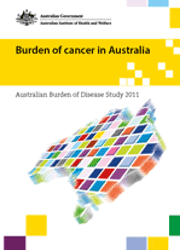Summary
Burden of disease analysis measures the combined impact of dying prematurely, as well as living with disease. More than merely counting deaths or disease incidence and prevalence, burden of disease analysis takes into account age at death and severity of disease for all diseases, conditions and injuries, in a consistent and comparable way. This report presents detailed findings on the burden due to cancer in Australia using results from the Australian Burden of Disease Study 2011.
Cancer burden greatest of all disease groups but improving
Cancer was the greatest cause of health burden in Australia in 2011, accounting for around one-fifth (19%) of the total disease burden. Cancer was ranked ahead of cardiovascular diseases (15%) despite having fewer deaths and lower disease prevalence. This is mainly the result of people dying earlier from cancer than cardiovascular diseases. Most (94%) of the burden from cancer was due to dying prematurely, with only a small proportion due to living with a cancer diagnosis.
Almost half (48%) of the total cancer burden in 2011 is from 5 cancers—lung, bowel, breast, prostate and pancreatic cancers—and almost one-quarter (22%) of the total cancer burden can be attributed to tobacco use.
The cancer burden has improved since 2003, with a 10% decline in age-standardised rates of overall burden. Improvements are evident across most cancer types (except liver and thyroid cancer), with the bulk of the improvement due to a decline in the fatal burden of lung, breast and bowel cancers through a shift towards dying at older ages.
These improvements are generally expected to continue to 2020 with expected falling mortality rates; however, both the fatal and non-fatal burden of lung cancer in females and liver cancer in both sexes is expected to increase with increasing incidence and mortality.
Higher cancer burden in Indigenous Australians
Indigenous Australians experienced 1.7 times the cancer burden of non-Indigenous Australians. In particular, Indigenous males experience 2.3 times the lung cancer burden of non-Indigenous males, and Indigenous females 2.6 times the lung cancer burden of non-Indigenous females.
The improvements observed in cancer burden nationally were not reflected in the Indigenous population, with a small increase in the age-standardised rates of overall cancer burden between 2003 and 2011.
Burden increases with increasing remoteness and decreasing socioeconomic position
The burden of lung, bowel, prostate and pancreatic cancers increased with increasing remoteness. The rate of cancer burden increased with decreasing socioeconomic position, with people in the lowest socioeconomic group experiencing 1.4 times the cancer burden of people in the highest group. In particular, the rate of lung cancer burden in the lowest group is almost twice the rate in the highest group.
Preliminary material: Acknowledgments; Abbreviations; Symbols
1 Introduction
- What is burden of disease?
2 Methods summary
- Definition of cancer in ABDS 2011
- Cancer of unknown primary site
- Ductal carcinoma in situ
- How is the burden of cancer measured?
- How is the contribution of risk factors measured?
- Where do the data for cancer burden come from?
- Quality of cancer burden of disease estimates
3 Cancer burden in 2011
- Cancer burden in context of other disease groups
- Overview of cancer burden
- Fatal burden of cancer
- Non-fatal burden of cancer
- Burden attributable to specific risk factors
4 Cancer burden in key population groups
- Cancer burden in Aboriginal and Torres Strait Islander populations
- Cancer burden by state and territory
- Cancer burden by remoteness
- Cancer burden by socioeconomic position
5 Change in cancer burden since 2003
- Change in total cancer burden
- Drivers of the change in cancer burden
- Changes in risk factors for cancer
- Change in cancer burden in Indigenous Australians
6 Potential cancer burden in 2020
- Potential fatal burden in 2020
- Potential non-fatal burden in 2020
Appendixes:
- Appendix A: Methods
- Appendix B: Additional tables and figures
End matter: Glossary; References; List of tables; List of figures; Related publications



